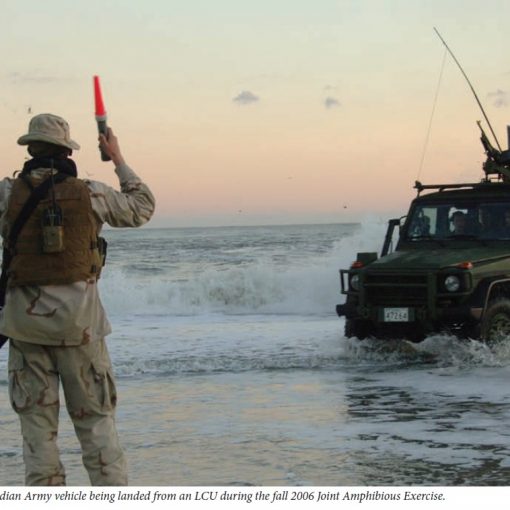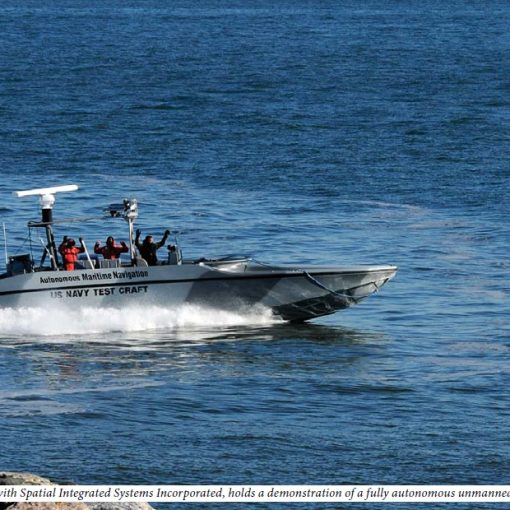The economic crisis has become a catalyst for a variety of national and local infrastructure projects. Although this makes sense, the scope could be much broader. To those of us with maritime and oceans concerns, the crisis offers an opportunity to reverse some earlier bad decisions and put Canada back on the path to technological leadership in the maritime sector. In this, some lessons from the past and some simplified rationale for maritime infrastructure make a case for rejuvenating Canada’s shipbuilding industry.
Why does the shipbuilding industry warrant special consideration? Contrary to popular belief, shipbuilding is far broader in scope than just the fabrication of ships’ hulls and propulsion systems. Modern ships are complex, regardless of their purpose, and this in turn has given rise to many research and development (R&D) initiatives to increase operating efficiency and greater fuel economy. Look, for instance, at the newest generation of container ships or the highly specialized vessels used in the offshore oil and gas industry and you will see concepts in use today that were just dreams a few years ago. Modern warships need levels of versatility and endurance not anticipated 25 years ago. Only about 30% of the cost of a new warship now goes into the hull and propulsion system, while most of the rest of the price goes to the systems that give the ship the necessary operational flexibility. The result of these changes is that the shipbuilding industry now draws in a wide range of other engineering capabilities as well as the R&D community. Shipbuilding has become a truly national industry, and as evidenced by the patrol frigate program 20 years ago, includes industrial facilities in every province and most large cities. Unfortunately, subsequent government inertia and some misguided political views that Canada’s new ship requirements could be met best through foreign rather than domestic contracts resulted in a downturn in the Canadian shipbuilding industry. This not only cost many good jobs in high-tech industries, but has also eroded the greater Canadian industrial base.
What can history tell us? When Franklin Delano Roosevelt became President of the United States in 1932 confronting the Depression was not his only problem. It was the most pressing problem but the deteriorating situation in Asia as a result of Japan’s growing imperialism also needed attention. Within this, the 1922 Washington Naval Agreement which was supposed to create a balance of naval power in the Pacific was beginning to unravel, leaving the United States at a strategic disadvantage. In the 1920s the US Navy was in a somewhat similar situation to that in which the Canadian Navy finds itself today: a sensible policy for modernizing the fleet existed but the government of the day would not provide the funds to make it happen. In the American case, the government had embraced disarmament a little too enthusiastically while retreating from the world stage in a flurry of isolationism. In Canada, the navy has not been given the political priority needed to ensure its continuing usefulness as an instrument of both foreign policy and national security. Roosevelt’s 1932 shipbuilding program (which was soon followed by commitments to build more warships) allowed him to begin addressing the unfavourable strategic situation while creating much-needed work in an important sector of the economy. His time spent earlier as Under-Secretary for the Navy taught him not only that an effective navy was essential for national security but also that the shipbuilding industry, in its broadest sense, could be an economic stimulus for the country as a whole.
How does the Roosevelt model apply to Canada today? To answer that question we need to look briefly at Canada’s strategic setting and then ask why Canada needs a navy. The strategic setting is really quite easy to understand: Canada is a large country with extensive ocean and maritime interests including dependence on international trade by sea and extensive ocean resource exploitation and management requirements. Canada has responsibility for a vast ocean area almost as big as the Canadian landmass but does not have the means to exercise that responsibility properly: there are not enough specialized ships and much of the related infrastructure does not exist. Concerns over diminishing Arctic ice and the resultant opening of the Arctic waters to mass transportation, exploration and resource exploitation are almost certainly the most pressing ocean ‘management’ issues today. Maintaining Canadian sovereignty and thus control over activities in those waters as well as being able to respond to the inevitable emergencies demand a Canadian government presence in all those waters. The complexity of the tasks requires that this presence be military in most situations. A Coast Guard can undertake many of the safety and simple law-enforcement tasks but is not trained or equipped to manage violence, major disasters, or foreign intrusions. Hence, much of the complex job of maintaining Canadian government presence at sea and providing the necessary deterrent to lawlessness falls to the navy.
A second dimension of the requirement for a navy comes from the need for Canada to be active globally in the interests of international security, especially the security of international trade by sea and humanitarian intervention. For much of the last 100 years Canada has used its navy to further those objectives, and will almost certainly need to do so in the future. This foreign policy role of the navy is no less important than the national security role, and is really an extension of the national security role because today no industrialized state can be an island unto itself. Events that take place far from home often have national security implications. Also, a navy is the first response to crisis and naval force has the advantage of allowing politicians a high degree of flexibility in making an initial response – a feature not shared by either air forces or armies.
So, why does Canada need a new shipbuilding program? On the assumption that it makes sense politically to maintain an effective navy able to operate in all Canadian waters and be a versatile instrument of foreign policy, it makes equal sense to apply some of the new infrastructure funding to maintaining that capability especially where it is in danger of lapsing. In contrast to Roosevelt’s long-range strategic weakness in the 1930s, the emerging Canadian strategic weakness lies closer to home. Regardless of which version of the imminence and impact of Arctic warming one accepts, the fact is that the Arctic waters are changing and there will be greater general access to those waters. Without the means to enforce laws, respond to emergencies, and generally oversee the orderly use of those waters, the new frontier has the potential to be as lawless and violent as the old American West. Opportunities for resource exploitation in the northern lands are just too great. To maintain Canadian sovereignty over those waters a firm government presence, as both a deterrent and an enforcement capability, is needed now. The problem is that the present naval fleet and the Coast Guard only have a limited capability to work in those waters. What Canada needs, sooner rather than later, is a fleet of new Arctic Patrol Vessels.
Designing and building such a vessel in Canada is a logical infrastructure project to stimulate the economy. As explained earlier, shipbuilding is a multi-disciplinary undertaking with potential benefits in just about every part of the country. To take advantage of this opportunity the government needs to move quickly through the design and contract phase and begin cutting steel as soon as possible. Because the government contracting process now moves at glacial speed some means need to be found to expedite the process. Perhaps it would be possible to rejuvenate the whole shipbuilding industry in Canada with a series of projects, to address all the present naval and Coast Guard deficiencies, on the understanding that the work will be divided up fairly among all the players. This would require an approach to contracting that casts aside the traditional politics of procurement and strives for an industrial package that is in the country’s best strategic and economic interests. In this, Canada would be well advised to heed the lessons of Roosevelt’s 1932 shipbuilding initiatives.



